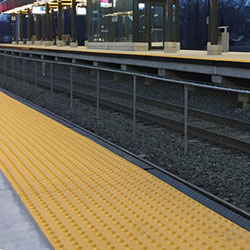









Tactile attention indicators, also known as Tactile Walking Surface Indicators (TWSI), are an important accessibility feature required by the Ontario Building Code (OBC) to help visually impaired persons safely navigate buildings and public spaces.
As a leading supplier of tactile products, we at Tactile Solution Canada want to provide a comprehensive overview of what the current OBC says about tactile attention indicators to help architects, contractors, building owners, and property managers understand the code requirements and select compliant products.
The key section outlining standards for tactile attention indicators in the current OBC is Section 3.8.3.18. It states that where a tactile attention indicator is required, it shall conform to the specifications outlined in Sentence (2) and Clauses 4.1.1 and 4.1.2 of ISO 23599 standard for Assistive Products for Blind and Vision-Impaired Persons – Tactile Walking Surface Indicators.
Some key criteria for OBC-compliant tactile attention indicators as per ISO standard 23599 are:
The OBC mandates the installation of tactile attention indicators in the following locations:
Per OBC 3.8.3.17, tactile attention indicators must be installed:
This alerts those with vision impairments that they are approaching a set of stairs.
As per OBC 3.8.3.17, tactile indicators are required:
This prevents people from unintentionally walking off the edge of an elevated or steeply sloped platform.
Per OBC 3.8.3.18, tactile attention indicators must be demarcated:
This warns pedestrians when they are entering a potentially dangerous vehicular travel way.
The OBC requires tactile attention indicators to have truncated dome textures with specific dimensions:
Dome Top Diameter Spacing
These specifications allow the tactile cues to be easily discernible underfoot and detectable with a cane without posing a tripping risk.
How Tactile Solutions Can Help
At Tactile Solutions, we supply a wide range of OBC-compliant tactile attention indicators to help buildings and public spaces meet Canadian accessibility standards. Our products are:
With over 20 years of experience supplying tactile solutions across Canada, we can recommend the right products for your specific project requirements. We also provide hassle-free shipping across the country.
Our customer service team is happy to answer any questions on OBC tactile indicator requirements and provide code consultation. We aim to ensure architects, contractors and property owners have access to compliant tactile safety solutions for all projects.
A: Indoors, tactile attention indicators are commonly installed at stair nosings, elevated platforms and stages, exit doors, accessibility ramps, and high-contrast surroundings to define paths of travel.
A: These products come with rear-applied tape or can be installed using mechanical fasteners. Set into fresh concrete during new construction. Indicators must be flush with the ground surface.
A: With proper installation and maintenance, quality-compliant tactile indicators can last 10-15 years outdoors and 20+ years indoors. Replace immediately if damaged, lifted or missing.
Let Tactile Solution Canada help make your building or public space accessible and OBC-compliant with quality tactile indicators installed correctly. Contact our experts today to discuss your tactile attention indicator needs.
